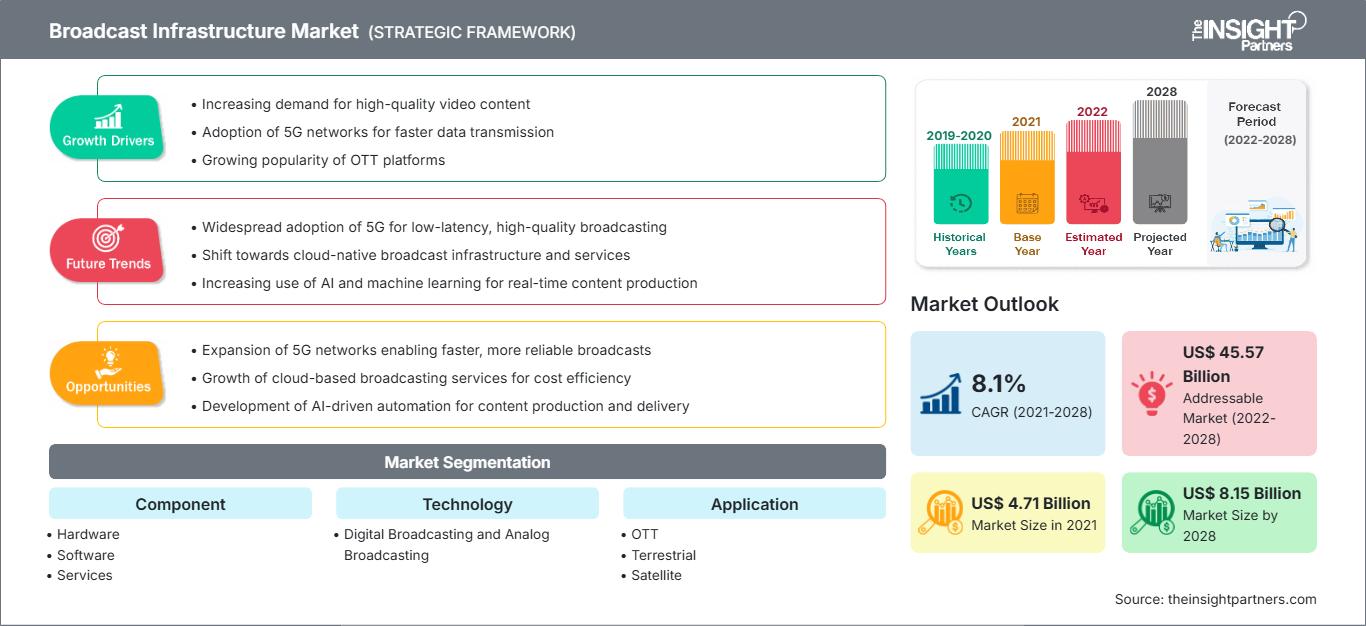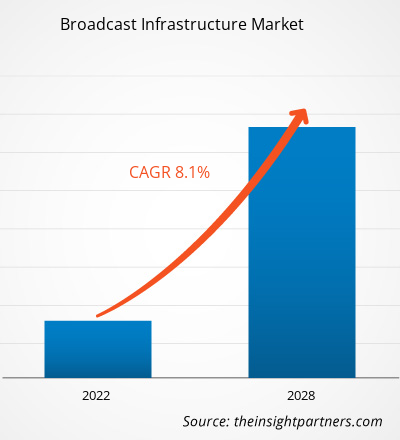[研究报告]2021年,广播基础设施市场价值为47.137亿美元,预计到2028年将达到81.457亿美元;预计2021年至2028年的复合年增长率为8.1%。
广播行业从模拟技术向数字技术的范式转变,带来了先进的广播基础设施,这些基础设施相对复杂。广播行业对互联网协议电视 (IPTV)、网络电视、高清电视 (HDTV) 和按次付费等新型广播技术的需求日益增长。对丰富视频体验的需求预计将为全球(尤其是亚洲)的广播公司铺平道路。推动广播基础设施市场发展的另一个关键因素是集成平台,该平台由服务器、机顶盒和视频内容保护系统组成,并配备相应的工具、中间件和计费系统,从而能够基于底层IP网络和DSL或光纤接入系统的组合,提供多种格式的电视服务,例如视频点播、流媒体和时移电视。如今,由于广播硬件基础设施成本高昂、维护成本高昂以及硬件升级频繁,供应商正在从基于硬件的基础设施转向基于软件的基础设施。广播行业一直在经历革命性的创新,技术不断发展,旨在为用户提供更好的体验,并为广播基础设施供应商创造机遇。
自定义此报告以满足您的要求
您将免费获得任何报告的定制,包括本报告的部分内容,或国家级分析、Excel 数据包,以及为初创企业和大学提供超值优惠和折扣
广播基础设施市场: 战略洞察

- 获取本报告的主要市场趋势。这个免费样本将包括数据分析,从市场趋势到估计和预测。
新冠疫情对广播基础设施市场的影响
您将免费获得任何报告的定制,包括本报告的部分内容,或国家级分析、Excel 数据包,以及为初创企业和大学提供超值优惠和折扣
广播基础设施市场: 战略洞察

- 获取本报告的主要市场趋势。这个免费样本将包括数据分析,从市场趋势到估计和预测。
新冠疫情期间,大量个人居家办公,花费更多时间上网,并推动数字化转型。这种对数字资源的需求进一步加重了众多软件和平台公司的系统压力,削弱了它们提供可靠优质服务的能力。然而,由于企业停工和劳动力短缺,新冠疫情对为最终用户提供视频内容的参与者产生了负面影响。由于企业停工、旅行禁令和供应链中断,新冠危机还彻底颠覆了整个价值链的运营,从供应商网络到客户交付体验。
市场洞察 — 广播基础设施市场日益采用新的广播技术
随着数字化程度的不断提高和可支配收入的增加,市场正在见证 IPTV 和 HDTV 的高普及率。对丰富视频体验的需求预计将为全球(尤其是亚洲)的广播公司铺平道路。由于消费者按需观看,亚太地区的宽带普及率正在不断提高。此外,Netflix 等基于订阅的 OTT 平台在亚洲也越来越受欢迎。预计政府在云基础设施、云解决方案和托管服务以及混合网络方面的支出将增加,这将推动广播基础设施市场的增长。日益增长的安全担忧和维护客户信任将鼓励广播公司采用新的交付模式。所有这些进步和发展都可能对预测期内的市场增长产生积极影响。
基于组件的洞察
根据组件,广播基础设施市场细分为硬件、软件和服务。软件部门在 2020 年占据了最大的市场份额。
广播基础设施市场
The Insight Partners 的分析师已详尽阐述了预测期内影响广播基础设施市场的区域趋势和因素。本节还讨论了北美、欧洲、亚太地区、中东和非洲以及南美和中美洲的广播基础设施市场细分和地域分布。
广播基础设施市场报告范围
| 报告属性 | 细节 |
|---|---|
| 市场规模 2021 | US$ 4.71 Billion |
| 市场规模 2028 | US$ 8.15 Billion |
| 全球复合年增长率 (2021 - 2028) | 8.1% |
| 历史数据 | 2019-2020 |
| 预测期 | 2022-2028 |
| 涵盖的领域 |
By 组件
|
| 覆盖地区和国家 | 北美
|
| 市场领导者和主要公司简介 |
|
广播基础设施市场参与者密度:了解其对业务动态的影响
广播基础设施市场正在快速增长,这得益于终端用户需求的不断增长,而这些需求的驱动因素包括消费者偏好的不断变化、技术进步以及对产品优势的认知度不断提高。随着需求的增长,企业正在扩展其产品线,不断创新以满足消费者需求,并利用新兴趋势,从而进一步推动市场增长。

- 获取 广播基础设施市场 主要参与者概述
广播基础设施市场的参与者主要专注于开发先进高效的产品。
- 2021年6月,领先的广播和新媒体制作现场视频技术提供商EVS宣布与Gravity Media合作,提供Xeebra多摄像机审阅系统作为该公司全新集成视频裁决和通信解决方案的核心技术。
- 2021年6月,Ross Video宣布收购媒体资产工作流程解决方案公司Primestream。这些解决方案被各个垂直市场的客户所采用,包括企业、数字媒体、体育和广播。他们的解决方案旨在解决每个市场中独特且日益复杂的创意、业务和技术挑战。通过此次收购,Ross将自然而然地将其Streamline媒体资产管理解决方案与Primestream产品相结合,从而创建一个完全融合的图形和制作资产管理平台。
广播基础设施市场细分如下:广播基础设施市场—— 广播基础设施市场 - 按组件
- 硬件
- 软件
- 服务
广播基础设施市场 - 按技术
- 数字广播
- 模拟广播
广播基础设施市场 - 按应用
- OTT
- 地面
- 卫星
- IPTV
- 其他
广播基础设施市场 -
- 北美洲
- 美国
- 加拿大
- 墨西哥
- 欧洲
- 德国
- 法国
- 意大利
- 英国
- 俄罗斯
- 欧洲其他地区
- 亚太地区 (APAC)
- 澳大利亚
- 中国
- 印度
- 日本
- 韩国
- 亚太地区其他地区
- 中东和非洲 (MEA)
- 沙特阿拉伯
- 阿联酋
- 南非
- MEA 其他地区
- 南美洲 (SAM)
- 巴西
- 阿根廷
- SAM 其他地区
广播基础设施市场 & 公司简介
- 思科系统公司
- 克莱德广播技术公司
- CS 计算机系统有限公司
- Dacast 公司
- EVS 广播设备公司
- Grass Valley
- Kaltura
- Nevion
- Ross 视频有限公司
- Zixi
- 历史分析(2 年)、基准年、预测(7 年)及复合年增长率
- PEST和SWOT分析
- 市场规模、价值/数量 - 全球、区域、国家
- 行业和竞争格局
- Excel 数据集
近期报告
相关报告
客户评价
购买理由
- 明智的决策
- 了解市场动态
- 竞争分析
- 客户洞察
- 市场预测
- 风险规避
- 战略规划
- 投资论证
- 识别新兴市场
- 优化营销策略
- 提升运营效率
- 顺应监管趋势




















 获取免费样品 - 广播基础设施市场
获取免费样品 - 广播基础设施市场